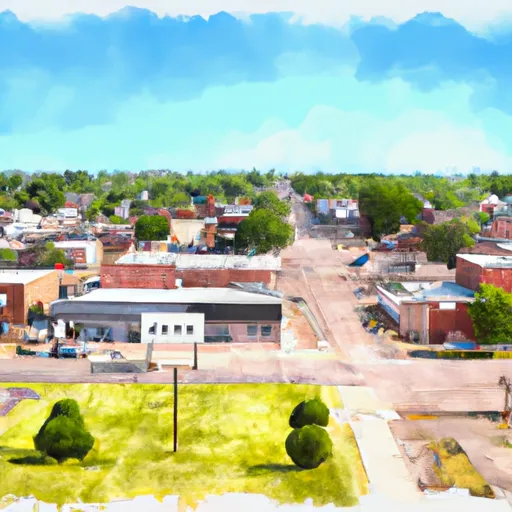-
 Snoflo Premium
Snoflo Premium
Get unlimited access to all our content
With no Ad interruptions! - Start Your Free Trial Login with existing account
Hopeton
Eden Index
Climate
9.9
•
Recreation
1.1
•
Community
•
Safeguard
4.3/10

Hopeton, Oklahoma is a small town located in Woods County, in the northwestern part of the state. The region experiences a continental climate with hot summers and cold winters. Average temperatures range from around 40°F in winter to 90°F in summer, with occasional extremes. Precipitation is relatively low, averaging about 25 inches per year, with most occurring during the spring and summer months.
Hydrologically, Hopeton is situated close to the Cimarron River, a major tributary of the Arkansas River. The area is also dotted with small ponds and lakes, providing opportunities for fishing and boating enthusiasts. These water sources support a diverse range of fish species, including largemouth bass, catfish, and crappie.
Outdoor recreation opportunities in Hopeton are abundant. The town is surrounded by picturesque landscapes, making it popular for hiking, camping, and wildlife observation. The area is home to several wildlife management areas and state parks, offering opportunities for hunting and birdwatching. Additionally, the nearby Cimarron River provides opportunities for canoeing and kayaking.
Overall, Hopeton, Oklahoma offers a favorable climate, diverse hydrology, and a variety of outdoor recreation opportunities, making it an attractive destination for nature enthusiasts.
What is the Eden Index?
The Snoflo Eden Index serves as a comprehensive rating system for regions, evaluating their desirability through a holistic assessment of climate health, outdoor recreation opportunities, and natural disaster risk, acknowledging the profound impact of these factors on livability and well-being.
Climate Health Indicator (CHI): 9.9
Hopeton receives approximately
722mm of rain per year,
with humidity levels near 73%
and air temperatures averaging around
15°C.
Hopeton has a plant hardyness factor of
6, meaning
plants and agriculture in this region thrive during a short period during spring and early summer. Most
plants will die off during the colder winter months.
By considering the ideal temperature range, reliable water supplies, clean air, and stable seasonal rain or snowpacks, the Climate Health Indicator (CHI) underscores the significance of a healthy climate as the foundation for quality living.
A healthy climate is paramount for ensuring a high quality of life and livability in a region, fostering both physical well-being and environmental harmony. This can be characterized by ideal temperatures, reliable access to water supplies, clean air, and consistent seasonal rain or snowpacks.
Weather Forecast
Streamflow Conditions
Lower Cimarron
Area Rivers
Lower Cimarron
Snowpack Depths
Lower Cimarron
Reservoir Storage Capacity
Lower Cimarron
Groundwater Levels
Recreational Opportunity Index (ROI): 1.1
The Recreational Opportunity Index (ROI) recognizes the value of outdoor recreational options, such as parks, hiking trails, camping sites, and fishing spots, while acknowledging that climate plays a pivotal role in ensuring the comfort and consistency of these experiences.
Access to outdoor recreational opportunities, encompassing activities such as parks, hiking, camping, and fishing, is crucial for overall well-being, and the climate plays a pivotal role in enabling and enhancing these experiences, ensuring that individuals can engage in nature-based activities comfortably and consistently.
Camping Areas
| Campground | Campsites | Reservations | Toilets | Showers | Elevation |
|---|---|---|---|---|---|
| Longdale Area - Canton Lake | None | 1,628 ft | |||
| Pratt County Veterans Memorial Park | 17 | 1,811 ft | |||
| Canadian - Canton Lake | None | 1,643 ft | |||
| Blaine Park - Canton Lake | None | 1,579 ft | |||
| Cleo Springs RV Park | None | 1,275 ft | |||
| Crowder Lake University State Park | None | 1,573 ft | |||
| Medicine Lodge City Park | 5 | 1,466 ft | |||
| Sandy Cove - Canton Lake | None | 1,633 ft | |||
| Big Bend - Canton Lake | None | 1,674 ft |
Nearby Fishing
Nearby Ski Areas
Catastrophe Safeguard Index (CSI):
The Catastrophe Safeguard Index (CSI) recognizes that natural disaster risk, encompassing floods, fires, hurricanes, and tornadoes, can drastically affect safety and the overall appeal of an area.
The level of natural disaster risk in a region significantly affects safety and the overall livability, with climate change amplifying these risks by potentially increasing the frequency and intensity of events like floods, fires, hurricanes, and tornadoes, thereby posing substantial challenges to community resilience and well-being.
Community Resilience Indicator (CRI):
The Community Resilience Indicator (CRI) recognizes that education, healthcare, and socioeconomics are crucial to the well-being of a region. The CRI acknowledges the profound impact of these elements on residents' overall quality of life. By evaluating educational resources, healthcare accessibility, and economic inclusivity, the index captures the essential aspects that contribute to a thriving community, fostering resident satisfaction, equity, and social cohesion.

